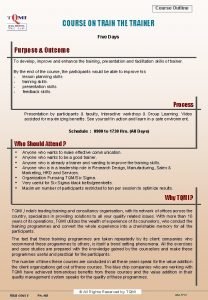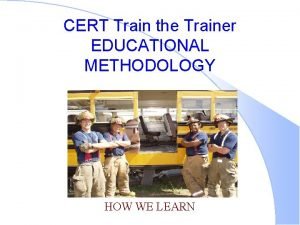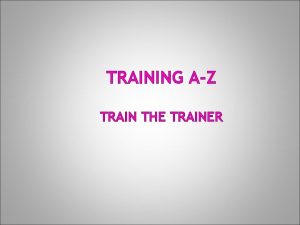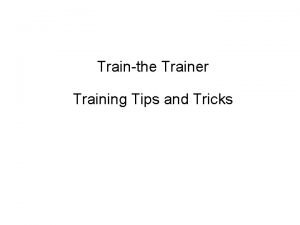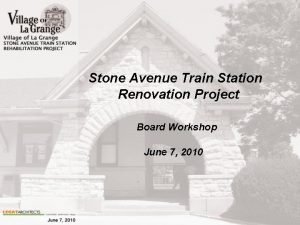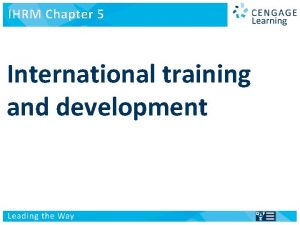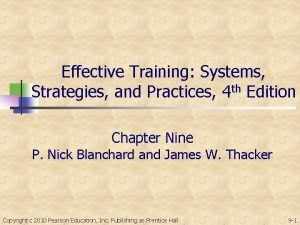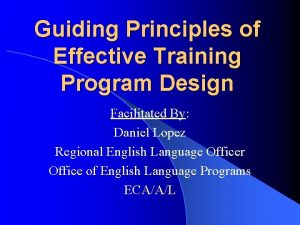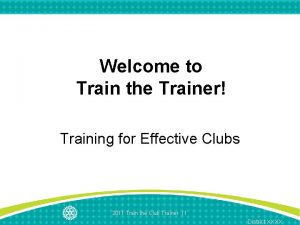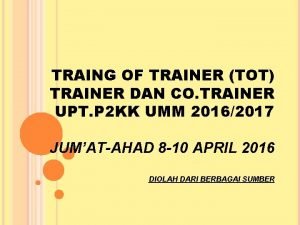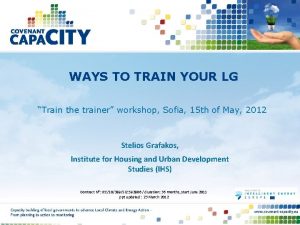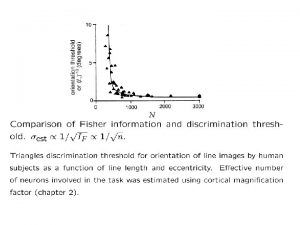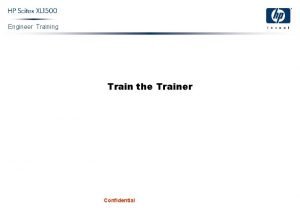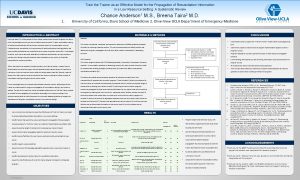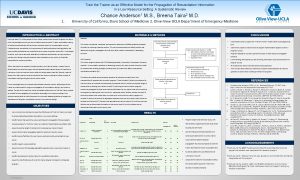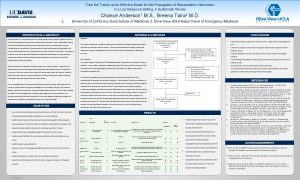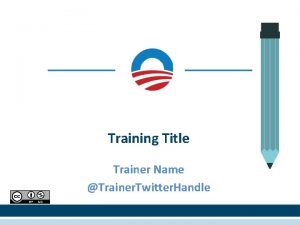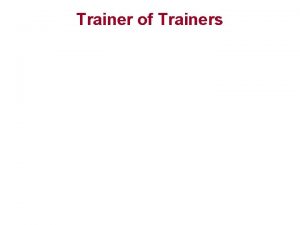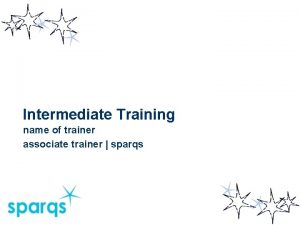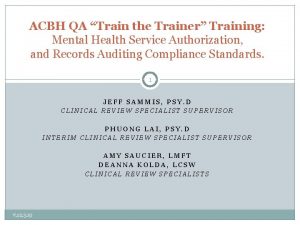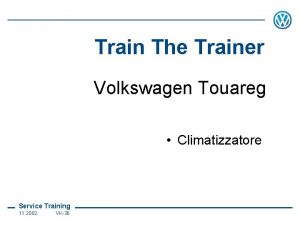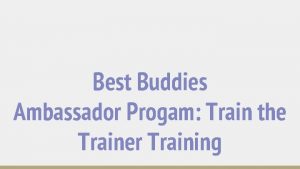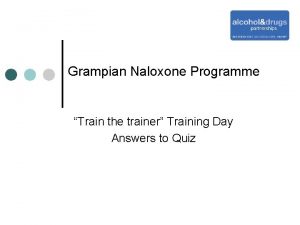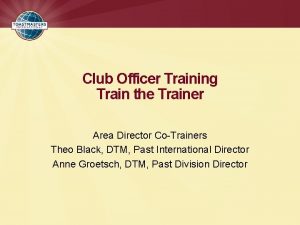Welcome to Train the Trainer Training for Effective

































- Slides: 33

Welcome to Train the Trainer! Training for Effective Clubs 2011 Train the Club Trainer | 1 District XXXX

Seminar Purpose This training seminar is designed to prepare training leaders to effectively train Rotarians. 2011 Train the Club Trainer | 1 District XXXX

Session 1: Leadership Development Training 2011 Train the Club Trainer | 1 District XXXX

Learning Objectives • Understand the Leadership Development Training Cycle. • Know the training needs in your Club • Understand your role as a training leader. 2011 Train the Club Trainer | 1 District XXXX

Club Trainer • Appointed by the club president, • Create training programs that meet the club's needs. • Club trainers work with the district trainer, assistant governor, and governor. 2011 Train the Club Trainer | 1 District XXXX

A Club Training program should • Ensure that club leaders attend district meetings • Provide consistent and regular orientation for new members • Offer ongoing educational opportunities for current members • • Create a leadership-skills development program for all members • Help the club to create a strategic plan 2011 Train the Club Trainer | 1 District XXXX

Leadership development program To develop members' personal, professional, and club leadership skills topics should include • Communication skills • Leadership styles • Leading and motivating volunteers • Mentoring • Time management • Goal setting and accountability • Strategic planning • Ethics and The Four-Way Test • Building consensus • Teamwork 2011 Train the Club Trainer | 1 District XXXX

Your Role at the Meeting • Ensure that participants learn. • Follow the training plan for the session/meeting. • Follow up on unanswered questions. • Get permission from club BOD for new handouts. 2011 Train the Club Trainer | 1 District XXXX

Session 2: Training Rotarians 2011 Train the Club Trainer | 1 District XXXX

Learning Objectives • Understand the characteristics of an adult learner. • List ways that adults best retain information. • Use different presentation strategies. 2011 Train the Club Trainer | 1 District XXXX

Qualities of Adult Learners • • • Realistic Practical Experienced Unique Busy 2011 Train the Club Trainer | 1 District XXXX

Adult Learner Retention Adults retain information that is • Interesting • Repeated • Applicable to their daily lives • Reinforced with interactive activities 2011 Train the Club Trainer | 1 District XXXX

Presentation Strategies • • Demonstrate enthusiasm. Know the material. Face the participants. Avoid using fillers (such as “uh” or “um”). Avoid excessive movement. Write neatly and spell correctly. Pace yourself, so participants can take notes. 2011 Train the Club Trainer | 1 District XXXX

Session 3: Facilitating Learning 2011 Train the Club Trainer | 1 District XXXX

Learning Objectives • Describe the characteristics of a good facilitator. • Explain different techniques used in facilitated discussion. 2011 Train the Club Trainer | 1 District XXXX

A Good Facilitator • • • Explores critical issues through questioning Creates a safe environment for participation Keeps group focused and on schedule Neutralizes negative behavior Projects a positive image 2011 Train the Club Trainer | 1 District XXXX

Effective Facilitation Techniques • • Ask open-ended questions. Pose participant questions to group. Accept all comments without judgment. Correct misinformation respectfully. 2011 Train the Club Trainer | 1 District XXXX

Session 4: Nonverbal Communication 2011 Train the Club Trainer | 1 District XXXX

Learning Objectives • Summarize the different types of nonverbal communication. • Describe how to adapt your training based on nonverbal communication. 2011 Train the Club Trainer | 1 District XXXX

Types of Nonverbal Communication • • • Voice Facial expressions Gestures Silence Eye contact Use of space 2011 Train the Club Trainer | 1 District XXXX

Reading Cues If participants seem… Try… Uncomfortable Doing a “getting to know you” activity Uninterested Telling a story, doing an interactive activity, or using gestures for a more lively presentation Confused Giving or asking for examples, and allowing for questions Opposed Asking for their thoughts on the subject 2011 Train the Club Trainer | 1 District XXXX

Session 5: Time Management 2011 Train the Club Trainer | 1 District XXXX

Learning Objectives • Identify techniques for managing time. • Identify what materials you need in training room. 2011 Train the Club Trainer | 1 District XXXX

Time Management Techniques • • Begin and end sessions promptly. Distribute handout packets in advance. Prepare flip charts in advance. Request each group to report best idea (instead of all). • Allow breaks to energize participants. 2011 Train the Club Trainer | 1 District XXXX

What to Look for in Training Room • General room set-up • Training materials • Equipment (see Training Leader Preparation Worksheet at www. rotary. org for more details) 2011 Train the Club Trainer | 1 District XXXX

Effective Room set up-for Interaction A U-shape arrangement is informal and can seat up to 30 people comfortably. It’s recommended for facilitated discussion because it allows participants to take notes and encourages greater participation. 2011 Train the Club Trainer | 1 District XXXX

Room set-up for breakouts • A roundtable facilitates breakout sessions for group interaction and brainstorming when there is only one room for plenary and small group discussion sessions. Seats may be placed all around the table or only around the half facing the stage to make switching between presentation and group discussion easier. 2011 Train the Club Trainer | 1 District XXXX

Room set-up for snoozers A classroom setup allows 10150 participants to take notes and works best for lecture, presentation, or demonstration. 2011 Train the Club Trainer | 1 District XXXX

Session 6: Interactive Training Methods 2011 Train the Club Trainer | 1 District XXXX

Learning Objectives • Understand benefits of using interactive activities. • Identify techniques for making training interactive. 2011 Train the Club Trainer | 1 District XXXX

Benefits of Interactive Activities • Maintain interest and refocus attention. • Create comfortable atmosphere for expressing ideas. • Reinforce concepts learned. • Stimulate brain activity with physical movement. 2011 Train the Club Trainer | 1 District XXXX

Interactive Activities • • • “Getting to know you” activity Pair and share Voting Small groups Role play 2011 Train the Club Trainer | 1 District XXXX

Thank you for attending Train the Club Trainer! Questions… Comments? 2011 Train the Club Trainer | 1 District XXXX
 Train the trainer course outline
Train the trainer course outline Train the trainer objectives
Train the trainer objectives Cert train the trainer
Cert train the trainer Train the trainer agenda
Train the trainer agenda Train the trainer tips and tricks
Train the trainer tips and tricks Stone avenue train station
Stone avenue train station Wise men three clever are we
Wise men three clever are we Ihrm training and development
Ihrm training and development Effective training systems strategies and practices
Effective training systems strategies and practices Crabtree meaning
Crabtree meaning Principles of effective training
Principles of effective training Kontinuitetshantering i praktiken
Kontinuitetshantering i praktiken Novell typiska drag
Novell typiska drag Tack för att ni lyssnade bild
Tack för att ni lyssnade bild Returpilarna
Returpilarna Shingelfrisyren
Shingelfrisyren En lathund för arbete med kontinuitetshantering
En lathund för arbete med kontinuitetshantering Särskild löneskatt för pensionskostnader
Särskild löneskatt för pensionskostnader Vilotidsbok
Vilotidsbok Anatomi organ reproduksi
Anatomi organ reproduksi Vad är densitet
Vad är densitet Datorkunskap för nybörjare
Datorkunskap för nybörjare Stig kerman
Stig kerman Tes debattartikel
Tes debattartikel För och nackdelar med firo
För och nackdelar med firo Nyckelkompetenser för livslångt lärande
Nyckelkompetenser för livslångt lärande Påbyggnader för flakfordon
Påbyggnader för flakfordon Vätsketryck formel
Vätsketryck formel Offentlig förvaltning
Offentlig förvaltning Jag har nigit för nymånens skära text
Jag har nigit för nymånens skära text Presentera för publik crossboss
Presentera för publik crossboss Teckenspråk minoritetsspråk argument
Teckenspråk minoritetsspråk argument Kanaans land
Kanaans land Klassificeringsstruktur för kommunala verksamheter
Klassificeringsstruktur för kommunala verksamheter
